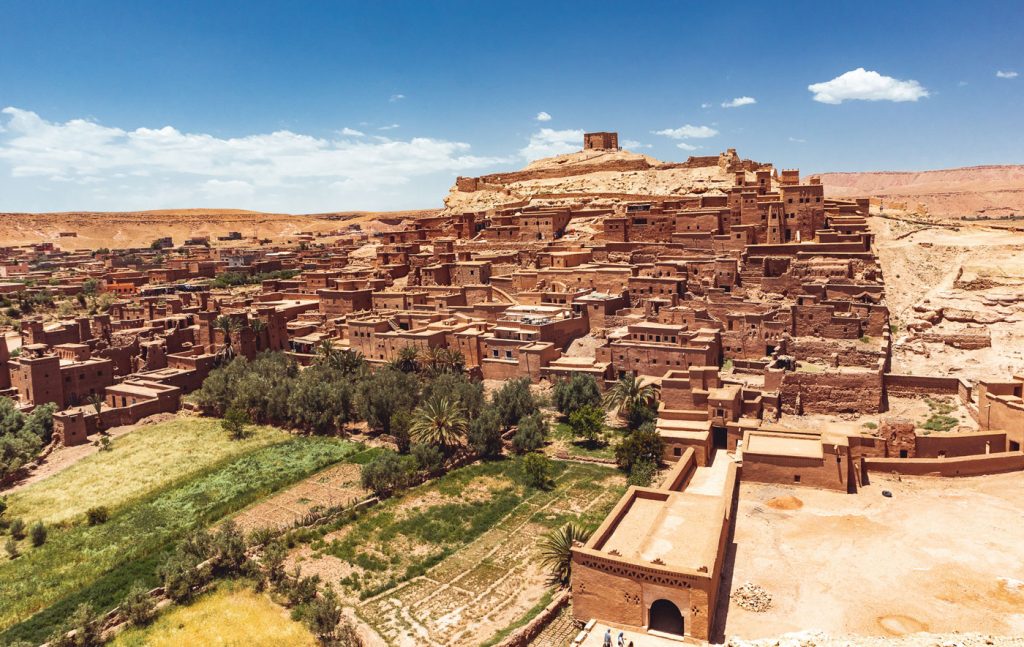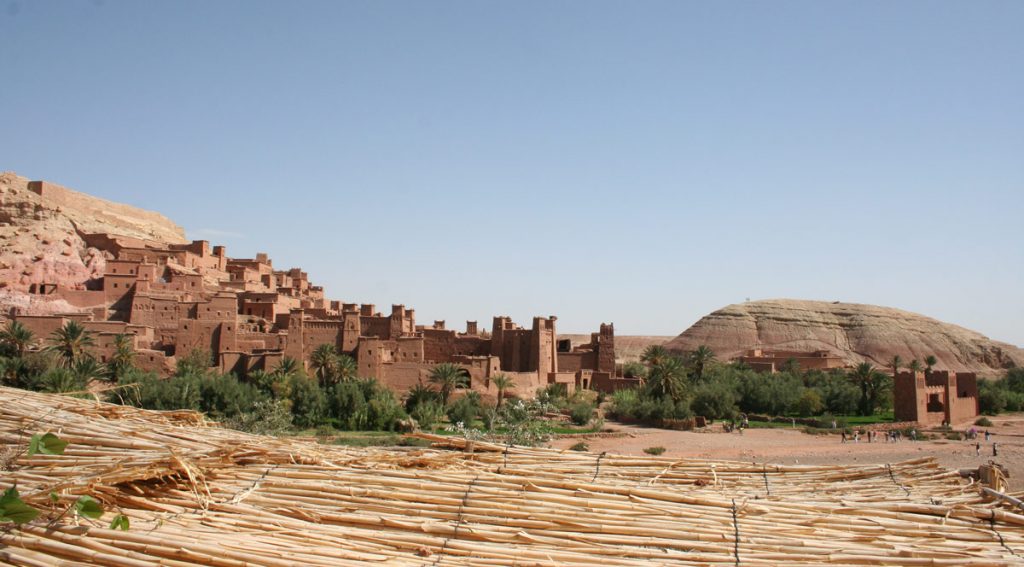Ait Benhaddou is a place where history, architecture, and the world of film converge. Nestled in the reddish shimmering landscape at the edge of the High Atlas Mountains, this clay village resembles a masterpiece of ancient design. Listed as a UNESCO World Heritage Site since 1987, it attracts visitors from all over the world. In this article, you’ll discover its history, unique construction, and cultural significance.
Located on the edge of the High Atlas Mountains and alongside the Ounila River, Ait Benhaddou is a vivid reminder of Morocco’s ancient caravan routes. This fortified village also plays a major role in international film history and offers deep insights into past ways of life. It remains a striking example of traditional Berber architecture.
Contents
- 1 Ait Benhaddou: What is it? Ksar vs. kasbah – key differences explained
- 2 History and significance: A crossroads of caravan routes
- 3 Ait Benhaddou as a legendary film location
- 4 Highlights and activities in Ait Benhaddou
- 5 Ait Benhaddou as part of a Morocco road trip
- 6 Getting to Ait Benhaddou
- 7 Accommodation in Ait Benhaddou: Spend a night in a clay village
- 8 Conclusion on Ait Benhaddou
- 9 FAQ
Ait Benhaddou: What is it? Ksar vs. kasbah – key differences explained
Ait Benhaddou (Aït Benhaddou) is a ksar, or fortified village. Unlike kasbahs, which are typically royal residences or fortresses, ksars consist of groups of houses, granaries, and public buildings surrounded by high defensive walls and towers.
This construction style is typical of the region south of the Atlas Mountains. The buildings are made of adobe, a mixture of clay and straw, which gives them their warm, reddish color and helps them blend seamlessly into the surrounding landscape.
Inside the ksar, you’ll find tighremts, which are multi-level homes with corner towers and crenellations. Their facades are often decorated with geometric patterns and reliefs that showcase the craftsmanship of Berber builders. Because these structures are vulnerable to the elements, they require regular maintenance and restoration.
The ksar itself is a maze of narrow alleys, interconnected homes, and small courtyards. Historically, it was divided into neighborhoods, each inhabited by different social groups. Today, only a few original families still live within the ksar. Most locals have moved to the new village area across the Ounila River, where modern amenities are available.

The Ounila River
The Ounila River separates the historic clay village from the newer settlement. In the past, it was a vital source of water and played an important role in caravan trade. Depending on the water level, the river is crossed either by a modern pedestrian bridge or via sandbags. The bridge, built in 2011, was intended to improve access and encourage the repopulation of the historic ksar.
History and significance: A crossroads of caravan routes
Ait Benhaddou dates back to the 11th century. It is believed to have been founded by the Almoravids as a Berber outpost and trading station. Due to its location in the Ounila Valley along one of the most important trans-Saharan trade routes between Marrakech, Fes, and the desert oases, the ksar became a crucial stopover. Salt, gold, spices, and even slaves were traded here. Caravans crossed the Atlas Mountains via the nearby Tizi N’Tichka Pass, and Ait Benhaddou served as a safe haven before entering the desert.
The ksar lost its economic importance when caravan routes declined in the 20th century. Many families relocated to the new village, where water, electricity, and infrastructure were more accessible. As the clay buildings began to deteriorate, extensive restoration projects started in the 1980s, supported by UNESCO and fueled by the increasing use of the site as a film location.
Today, Ait Benhaddou stands as a living testament to the region’s dynamic history, representing the architectural and cultural heritage of southern Morocco.

Ait Benhaddou as a legendary film location
No other place in Morocco has been used as frequently for film shoots as Ait Benhaddou. Its striking architecture, desert lighting, and atmospheric setting make it a favorite location for historical, adventure, and fantasy films.
Famous films and series shot here include:
- Lawrence of Arabia (1962)
- Jesus of Nazareth (1977)
- The Jewel of the Nile (1985) – a distinctive concrete gate was added for this film
- James Bond: The Living Daylights (1987)
- The Mummy (1999)
- Gladiator (2000) – many villagers participated as extras; props can still be seen in souvenir shops
- Alexander (2004)
- Prince of Persia: The Sands of Time (2010)
- Game of Thrones (2012) – the ksar served as the city of Yunkai, with added digital effects and set extensions
Other films such as The Last Temptation of Christ (1988) and Babel (2006) were also filmed here. Temporary sets were often built or existing structures adapted. Local residents benefit economically from film productions and from the international attention the ksar receives as a cinematic backdrop.
Highlights and activities in Ait Benhaddou
Entrance and opening hours
The ksar is open year-round and can be visited at any time. A small fee may be charged to enter the privately owned kasbahs near the main entrance. However, visitors can also access the kasbahs for free via the bridge. Visitors are kindly asked to respect the privacy of the residents.
Recommended activities in the ksar
- Wander through the narrow alleys: The village is compact and easy to navigate.
- Browse local crafts: Small shops sell handmade souvenirs, including postcards painted with saffron and tea, which are often made right before your eyes.
- Visit a traditional clay house: For a small fee, you can explore a few inhabited homes and get a glimpse into everyday life in the ksar.
Viewpoints
- From the top of the ksar: It offers panoramic views of the Ounila Valley, the new village, the surrounding palm groves, the Atlas Mountains, and the desert beyond. It is especially magical at sunset.
- First viewpoint (opposite the ksar): It is easily accessible and great for photos, especially in the late afternoon light.
- Second, distant viewpoint: It requires a short drive, but it provides a broader perspective of the ksar’s natural surroundings.
Best time to visit
The best times to explore Ait Benhaddou are early in the morning and late in the afternoon, when it’s less crowded. Most tour buses arrive around midday, so planning your visit for outside these hours will ensure a more relaxed experience.
Food and dining
There are no restaurants directly inside the ksar. Dining options can be found by the river or in the new part of town. One of the most popular spots is L’etoile Filante D’or, known for its flavorful tagines.
A bonus for horror movie fans
Just nearby on the N9 road between Ouarzazate and Amerzgane lies the Gas Haven film set from the horror movie The Hills Have Eyes. It’s open to the public and worth a quick stop for movie buffs.
Ait Benhaddou as part of a Morocco road trip
Whether you’re heading to Erg Chebbi, Erg Chegaga, or the Zagora desert, Ait Benhaddou is an ideal stopover on the way from Marrakech to the Sahara. A two- to three-hour visit is enough time to see the highlights. Allow a full day for travel and exploration from Marrakech.
Just 30 minutes away lies Ouarzazate, home to the world-famous Atlas Studios and the historic Kasbah Taourirt, which also served as a film location.
Other nearby attractions include the Kasbah Amridil, the dramatic Dades and Todra Gorges, and the remote Kasbah Telouet, located about 50 kilometers away.
Many organized desert tours from Marrakech include stops at Ait Benhaddou and other major sights in Southern Morocco.
Getting to Ait Benhaddou
Rental car or private vehicle
The drive from Marrakech is about 180 kilometers and takes three to four hours. The road crosses the scenic Tizi N’Tichka Pass, which offers stunning views and great photo opportunities. Parking is available in the new village area, and fees may vary by season.
Bus & taxi
There are regular buses from Marrakech to Ouarzazate. From there, Ait Benhaddou is about 30 kilometers away and can be reached by taxi.
Guided tours
If you’re not planning a full road trip, guided day tours from Marrakech are a great option. These tours usually include a visit to Ouarzazate and scenic stops along the way (Getyourguide).
Desert tour combinations
Most organized tours from Marrakech to the Sahara include a visit to Ait Benhaddou, allowing you to see two regional highlights on one trip (Getyourguide).
Accommodation in Ait Benhaddou: Spend a night in a clay village
Spending the night in Ait Benhaddou is a truly special experience. After sunset, the tourist crowds disappear, allowing the unique atmosphere of the ksar to truly come to life. Although accommodations are limited, they are excellent.
Here are a few recommended options:
- Kasbah Rayane Ait Benhaddou: Affordable and simple, with a pool and views of the ksar (Booking.com).
- Riad Paradise of Silence: A charming traditional riad with great attention to detail, a pool, and a terrace overlooking the ksar (Booking.com).
- Kasbah El Hajja: One of the few hotels located directly inside the ksar. It offers a touch of luxury and a breakfast view of the World Heritage Site (Booking.com).
Alternatively, day-trippers can stay in Marrakech.
Conclusion on Ait Benhaddou
Ait Benhaddou is a place where history, architecture, film, and nature converge in an unforgettable way. Its unique atmosphere and fusion of the past and present make it a must-see destination. As a visual and cultural gem, the ksar is an essential stop on any Morocco itinerary.
However, the site faces challenges, including the migration of young people, the need for constant maintenance, and natural threats, such as the 2023 earthquake. Nevertheless, Ait Benhaddou remains a place of deep historical and cultural significance — a living monument to Morocco’s rich heritage.
FAQ
No, access to the ksar is free. However, some privately owned kasbahs may charge a small entrance fee. There are also alternative free entrances.
Yes, overnight stays are possible and highly recommended. The village has a magical atmosphere, especially in the evening.
Two to three hours are usually enough to explore the ksar itself. If you’re coming on a day trip from Marrakech, you should plan for a full day.
Some of the most famous productions include Gladiator, Game of Thrones, Lawrence of Arabia, The Mummy, Prince of Persia, and many more.
A ksar is a fortified village consisting of multiple dwellings and storage buildings. A kasbah refers to a single fortified house, typically for a wealthy family.
You can easily explore the ksar on your own. But if you’re interested in deeper insights into its history and architecture, local guides are available on site.
